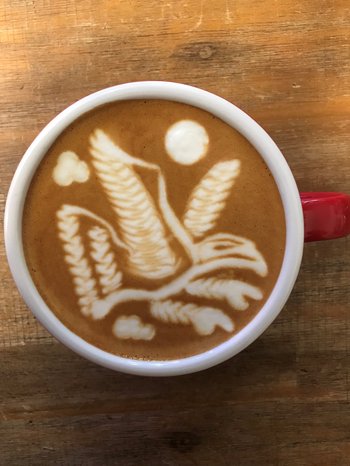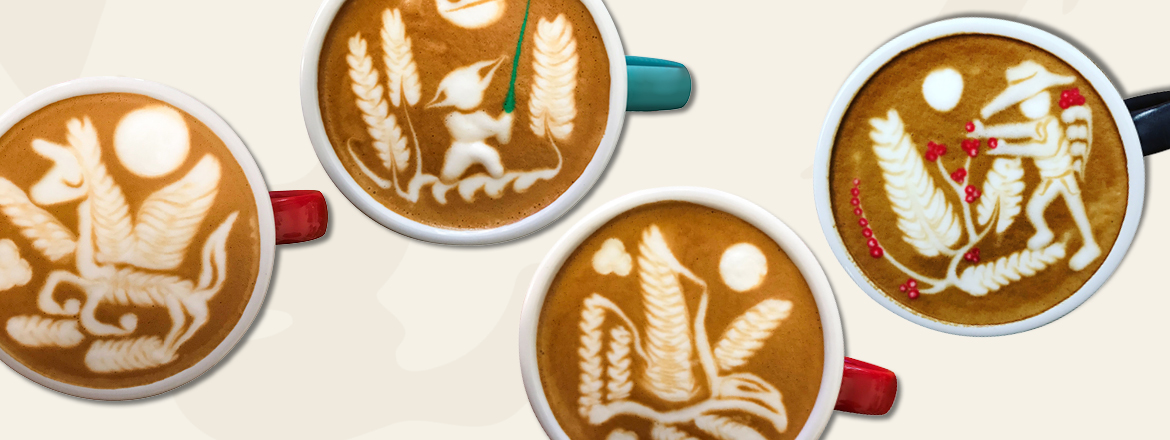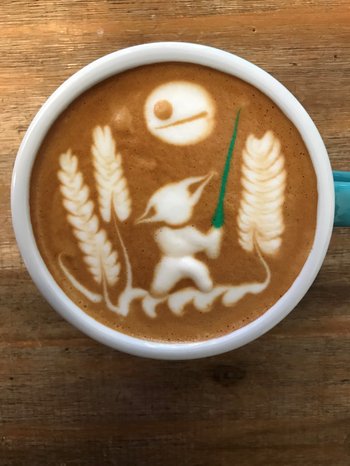A cup of coffee with Gregory Raymond
Swiss latte art master
We meet for a cup of coffee with Gregory Raymond and ask how he got to be a professional — and excellent — barista.
1. Let’s start in general terms with your professional career: How do you get to be a professional — and excellent — barista?
At the beginning of my career, I had nothing to do with coffee. It was only after studying international economics that I decided to pursue a career in gastronomy, more specifically in a restaurant that had been awarded two Michelin stars. Here I trained as a maître d’hôtel, or restaurant manager, from 2007 to 2013, and specialised in table arrangements. After that, I got a position as the person responsible for the service at a bistro from 2013 to 2015, which was followed by a position as manager of the Carasso Café branches in Geneva, where I still work today. It was then that I fully immersed myself in the world of coffee. At the same time, I also took part in the majority of the trainings offered by Ennio Cantergiani at the Swiss Coffee Academy.
In the beginning, so-called “latte art” played a major role. This was an impressive way to show guests that you know your craft and can handle an espresso machine. In the meantime, however, I have refined and expanded my skills even more in a number of workshops. This allows me to offer real “barista shows”, for example. As was appropriate, my introduction to the world of barista competitions was at the Swiss Latte Art Championships 2018. I got to the finals in my very first competition. In the following year, I won my first national title. Also in 2019, I was the Swiss Aeropress runner-up and Tyrolean runner-up. This winning streak continued last year and I managed to defend my title at the Swiss Coffee Championships. Thanks to this experience, I am now in a position to pass on my knowledge, for example with training courses that I offer on my own, or as a Black Level instructor for the Latte Art Grading System.
2. At what point did you realise that you wanted to work with coffee on a professional level?
I can answer that quite precisely: On my first day at Carasso, I knew I wanted to immerse myself in this complex and extremely interesting world. It was immediately clear to me that this would be the beginning of a long love story.
3. Where do you think the passion for coffee comes from?
“Appetite comes with eating”, as the saying goes. It was very similar for me and coffee. I drank coffee regularly, but beyond that I had no special interest in its preparation. Apart from a French press, I didn’t have any special machine at home. But my job gave me the chance to explore this amazing universe. And I have not regretted a thing since.
4. How would you describe your work at Carasso?
In simplified terms, you could say: My job at Carasso Cafés is to make sure customers are completely satisfied with their experience with us. I’m always there for our customers, whether they are interested in the coffee specialities themselves or in the machines and equipment. We work only with quality products and try to find the best possible solution for each and every one of our customers. It’s not about maximising profits. A crucial aspect here is also that we only use extremely high-quality products in our branches. Finding these products is my job. I examine them according to strict criteria and then pass my findings on to the whole team.
In this way, we try to get a little better every day and continue to expand our knowledge of coffee. In my job, the barista aspect is much more important than being a good salesperson, for example. Because if we manage to find out what customers like — through extensive consultations and our expertise — this brings them real added value.
5. Let’s talk about coffee itself: For you, what is the perfect cup of coffee?
That’s the million-dollar question. I think it’s very difficult to say, and the answer is certainly not objective. Because it’s not about how the coffee is prepared or how skilled the barista is — it’s just about individual taste. We all like our coffee a little differently. In the end, the most important thing is that you enjoy it. And you should not be afraid to try new things.
6. How did you discover your passion for latte art?
I very quickly discovered how aesthetic latte art is. When a customer sees an artistic creation on their milk beverage, it immediately has a positive effect on their mood. However, creativity and talent alone are not enough; the perfect milk texture is crucial. An added benefit is that you also get a better tasting drink. And, of course, latte art is just pretty cool.
7. How long did it take to develop and perfect the fish motif for the 2019 championships, for example?
In principle, the length of this process can vary greatly. Depending on the motif, it can be very quick or take a lot of time. I started working on this fish motif in 2017. And as I got better and better at it, I continued to improve the motif. When the 2019 championships came around, I finally had the first version ready. But as you can see from the photos of the 2021 version I prepared for the World Latte Art Battle in Seoul, quite a lot had changed.

8. Can you estimate roughly how many litres of milk you use by the time the motif is perfect?
Definitely too much, I’m afraid to say. And of course, a motif is never really perfect. You can always improve it. However, this means really quite a lot of milk is wasted, which is a problem.
9. Do you always have to practise with milk, or are there alternatives that can reduce milk waste? And is it possible to do without pure milk at the World Championships?
There has been a very interesting alternative for latte art around for some time now called “Barista Carl Blend” (BCB). This product is simply added to water and, once foamed, has a texture that is virtually identical to that of milk. But it’s still in the early stages of development. However, I’m sure that, after more research and development, it will be possible to achieve practically identical results with this product as with milk.
But I don’t know if the plan is to continue to use pure milk at the level of the World Championships. Basically, though, I think we really have to think about switching to BCB for international competitions in the future. After all, enormous amounts of milk are wasted just by training the participants.
10. Where do you get the inspiration for your designs?
That’s tough to answer — I don’t have a specific source of inspiration. My ideas just come to me when I’m practising. I always find it very interesting when I manage to imitate the shapes and motifs of the best latte artists in the world. That helps me develop my own ideas.
11. What motifs are you currently working on? Are there exciting aspects of the creation process you can share with us?
For the last few months, I have been training hard for the next Swiss championships, which will take place in Zurich in September — provided that the corona regulations allow it to happen. My new motifs are still secret, of course. But I can promise you this: Some of the creations I am working on will soon be on everyone’s lips.

12. As a real professional: What is your favourite way to drink coffee?
Even though espresso-based specialities still set the tone in the barista sector, I have a great weakness for gentler extraction methods. I am currently very fond of pour-over coffee prepared with special V60 filters.
13. What advice would you give to someone who wants to become a professional barista?
If you want to become a barista, you definitely need to have a lot of curiosity. And listening to customers is essential. But of course you also need a good education, that much is clear. You have to be aware at all times that constant concentration is required to become a better barista. That’s the advantage we have in the café — we are constantly learning and can apply our new knowledge and skills right away.
14. Finally, let’s take a little peak into the future: What trends do you see in the speciality coffee sector?
The way I see it – and I think my colleagues in the branches would agree — is that there is a clear tendency towards “doing it yourself”. In concrete terms, this means that more and more people want to make their own coffee again, like they used to. You can see this with filter coffee as well as with espresso. Many aim to get the maximum flavour in every cup. This goes hand in hand with the trend towards ever more diverse speciality coffees with increasingly specialised notes and flavours. Taken as a whole, this results in an extremely wide range of flavours. So, as with food or wine, people are always looking for new taste experiences with their coffee.



